This was published 3 years ago
‘Completely unimaginable’: How a business trip changed Stephenie’s life
She was the archetypal Sydney socialite – working hard and playing hard, with a shoe collection to match. Then a trip to Africa left Stephenie Rodriguez fighting for her life – and, eventually, losing her feet.
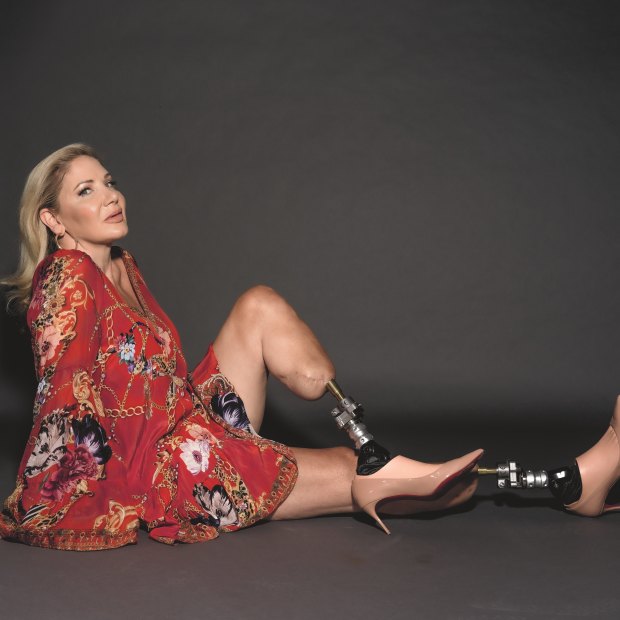
Stephenie Rodriguez was told she would never walk again unless she gave up her dead feet.Credit: Tim Bauer. Hair & make-up by Michelle Dubé
They’re a striking pair of shoes, and just a little daunting: 12-centimetre-high Chanel pumps, made of blue suede and fire-engine-red leather with matching piping. With barely a scuff on them after 14 years, it’s clear these heels have been well looked after and thoroughly loved.
When I make this observation to their owner, Stephenie Rodriguez, she gets a little misty-eyed and exhales a wistful “Oooooh, yeah”. Her yearning is
understandable. Six months ago, the American-born Sydneysider had both her feet amputated, then went on to become the first woman in Australia with above-ankle bilateral osseointegrated implants and mechanical feet.
The kids in her apartment building call her the “robot lady” – and she doesn’t mind a bit. “I just smile and show them my feet.”
The drastic surgery was the final chapter in an 18-month battle to save her life, following a mosquito bite in Nigeria that gave her cerebral malaria. The
single mother, former social-pages star and digital entrepreneur wound up battling severe neurological complications in a Boston hospital, where she was given only a 2 per cent chance of survival. At one stage, one of her necrosed, blackened toes fell off in her hand. “It was horrible, absolutely horrible. Completely unimaginable,” she says of that moment. “I couldn’t believe what I was seeing.”
Eventually, it was the Australian professor, Munjed Al Muderis, an Iraqi refugee who became a surgeon pioneering a new generation of robotic limbs, who convinced her that giving up her dead feet was her only chance of standing upright and walking again. “It’s bizarre, but I had to cut my feet off to walk again,” Rodriguez says bluntly.
Thirty-six surgeries and 368 hospital nights later, including endless hours of painful physiotherapy and pulsed radiofrequency treatments to her nerve endings, the 52-year-old is fit and well as she places the “Chanels”, as she calls them, in front of me. They’re the last vestige of a 400-pair collection of equally spectacular footwear by the likes of Christian Louboutin, Manolo Blahnik, Dior and Jimmy Choo that not so long ago graced her wardrobe, Carrie Bradshaw-style. “I never really felt ‘dressed’ until I had a pair of killer heels on; the higher, the better. That’s just the sort of girl I was ... still am,” Rodriguez explains. “They were all given away by my ex-husband ... I guess he didn’t think I’d ever need them again.”
But not the Chanels? “No, they were my first Mother’s Day present. There was no way I was ever going to part with them.”
We’re sitting on black leather sofas in her tasteful apartment on the 42nd floor of a modern complex in Sydney’s central business district. On one wall hangs an artwork by her friend Athena “X” Levendi, a former star of the TV show The Real Housewives of Sydney. “It speaks to me about transformation,” Rodriguez says of the painting, which depicts the human soul going through different phases. Her 15-year-old son Constantine sits nearby with headphones on, and from a corner, a space-age-looking massage chair occasionally speaks to us. “Oh, I call her Alice, ignore her,” Rodriguez says as the voice-reactive lounge offers its services.
“It’s bizarre, but I had to cut my feet off to walk again.”
It’s been a week since Rodriguez reached one of her greatest post-amputation milestones, learning how to walk in a comparatively modest pair of four-centimetre kitten heels. Today, she moves around the apartment in a pair of low-rise, leopard-print wedges with apparent ease. Protruding below her shins are the high-tensile titanium rods that have been fused into her bones. Attached to each rod, via an allen key, are two articulated prosthetic feet, which appear more like metallic paddles. Over these, Rodriguez has slipped a pair of flesh-toned silicone “covers”, complete with artificial toes and nails.
I think about the last time I saw her, over a decade ago. Back then, she was a blonde bombshell strutting into a crowded Mardi Gras party in Sydney’s Taylor Square wearing black, skin-tight pants and a bra-revealing top – all legs, lips and décolletage. She outshone even the most outrageous drag queens. Today, she jokes about a recent trip to the beauty parlour: “I’m the only woman I know able to have two procedures simultaneously in separate treatment rooms: a wax in one and a pedicure in the other!”
Rodriguez is sharing her tale with me in the hope that she can inspire others who face unimaginable adversity. She’s writing a book about her ordeal and hopes to join the speaker circuit. One of her main messages is to never take good fortune for granted: “It can be lost on the turn of a dime.” Of that she knows.

Rodriguez at Mardi Gras in 2010. Credit: Andrew Hornery
The middle child of three raised in Albany in upstate New York, then Virginia Beach, Stephenie Rodriguez always felt different. “There was a reason. At 16, I discovered I was a love child,” she says. “My mother had a relationship with a co-worker who turned out to be Puerto Rican, which explained why I looked different to my very fair siblings. I was browner, had the big eyes, the big nose, the lips.”
Angry with her mother for keeping her paternity secret, Rodriguez moved out of the family home and into her own apartment a few hours’ drive away,
attending school by day and waitressing by night. “It still amazes me! I guess I was a pretty independent kid, but I was also very driven, academically. I really enjoyed school and knew it was the key to getting on with my life.” She hired a private detective to track down her biological father, eventually meeting him in her 20s and, after becoming close, taking on his surname. (He died in 2008.)
Rodriguez hoped to win a scholarship to a prestigious Ivy League university, and dreamt of becoming a marine biologist, but after discovering she was “numerically dyslexic”, she went instead to the less salubrious West Virginia Tech, where she enrolled in a business degree. Various marketing roles during America’s first dotcom boom took her to Washington DC, then California. It was on a trip to Las Vegas in the mid-1990s, on a night out with a guy she was “not really into”, that she had a chance encounter that would ultimately bring her to Sydney.
“I was playing a slot machine in Vegas when a girl with an Australian accent came over and said her brother-in-law wanted to meet me,” she says. “He was this cute, young guy with Hugh Grant hair and schoolboy, tortoiseshell glasses, and that accent.”
The cute, young guy was a budding ear, nose and throat specialist named Michael Zacharia, who would go on to become one of Sydney’s most prominent plastic surgeons. “He invited me to lunch, and we talked a lot. About what we wanted in life ... our ambitions, everything. I ended up staying for dinner, too, and meeting his family. As I was leaving we kissed, and he looked me straight in the eye and said, ‘We will have a funny story to tell at our wedding reception.’ ”
Two years later, they did.
Rodriguez moved to Australia to be with Zacharia in 1997, but limited local career opportunities meant she continued working in the US, travelling regularly to Miami where she headed up business development for a Latin music MP3 service. It was here that she met the owners of a luxury lifestyle magazine called Ocean Drive.
“It was very glamorous, I could see the potential,” she says. Rodriguez convinced the owner to license her to launch it in Australia, which she did in 2001, diving headlong into Sydney’s heady social scene in the process. “I knew we had to make a splash,” she tells me. And she did, hosting a party for 1500 of Sydney’s movers and shakers in the ballroom at the then newly opened Westin Hotel on Martin Place, complete with disco podium dancers, fire-breathers and mime artists (I know; I was there).
Described in the social pages as the “perennial party girl”, “self-styled It girl” and “Ocean Drive supremo”, Rodriguez was also accused of attending “as many A-list style openings of envelopes as possible”. She couldn’t have cared less; always ambitious, she knew the marketing potential and played up to the persona, turning up to lunch at swanky Sydney restaurants in a denim jacket with Ocean Drive emblazoned in diamanté across the back.
The Zacharias’ marriage ended just after Melbourne Cup in 2002, where Rodriguez had been working the marquees. Pregnant with their first baby, she
miscarried. “The stresses of our respective careers meant we had drifted apart,” she says. All was not lost; she repurposed the diamonds from her engagement ring into a pair of earrings that she gifted to her now ex-husband’s niece.
While her glam magazine gave readers a glimpse into the world of ultra-chic homes, luxury fashion and prestige cars years before the advent of social media, it barely broke even and in 2004, Rodriguez says she had “no choice” but to kill it off. She remained a fixture in the gossip pages thanks to her unconventional ways, which included donating 12 of her eggs to a childless woman she’d met at a cocktail party as an act of “paying it forward”. Her donor son now attends the same school as Constantine, who was born in 2006 to Rodriguez and her second husband, property developer Paul Dermatis. Seven years later, the family moved to Dermatis’s home town of Canberra. The marriage ended in 2018; Rodriguez say it’s still too painful to talk about, but she remains “eternally grateful” for the son Dermatis gave her. Her beloved Constantine.
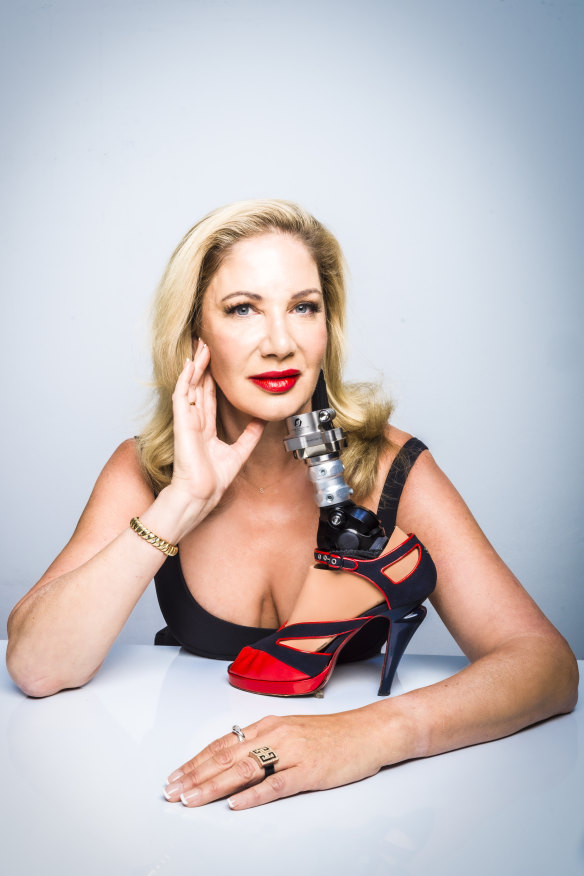
Her Chanel heels are the last vestige of a 400-pair collection. Credit: Tim Bauer
Newly single, Rodriguez buried herself in a start-up she’d launched in 2017 called WanderSafe, a high-tech keyring and personal safety app which, when activated, alerts contacts that something is wrong and shares the user’s GPS location. Her first big opportunity to market it came in April 2019 at the United Nations World Summit on the Information Society in Geneva, where she spoke about plans to roll it out around the world. The following month, Frontier Magazine judged it the best new travel accessory at a trade show in Singapore. Buzz was finally building.
In August, she flew to California to attend her first Hive Global Leaders Summit, an international forum for entrepreneurs to share ideas and seek business opportunities. She was invited to address Hive forums in Africa and India, and promptly said yes.
Just weeks earlier, she’d won a raffle at her local bar, Fenway Public House in the Canberra suburb of Woden. Her prize was a trip for two to Boston to see a baseball game at the famed Fenway Park. Her departure was scheduled for September 26, 2019, just 24 hours after she was due to return home from her trip to Africa and India. “A tight turnaround, sure, but I’d done that sort of thing for years, jet lag was second nature to me,” she says. It wouldn’t be a problem; lady luck was shining.
In Lagos, Nigeria, Rodriguez attended the Hive event on September 11, then a few days later spoke at a gathering of travel executives. “The organisers asked me to go outside for a photo shoot with delegates. They had drones, shot B roll [extra footage], and vox pops. It was filmed next to a pool of stagnant water. It was sunset. That’s when I believe I was bitten three times by a mosquito on my left ankle,” she says. She’d slathered herself in insect repellent, conscious of mosquito-borne diseases, but had opted not to take any anti-malarial drugs. “I’d had a bad reaction to one before,” she says. “I couldn’t afford to be slowed down.”
She’d largely forgotten about the bites when she flew to India the following day, where she spoke at New Delhi’s Women In Tech event at the Australian High Commission. On September 23, she flew back to Australia. Exhausted but running on adrenalin, she was excited for the next big adventure, one that would start the very next day: the all-expenses-paid, four-day trip to Boston, on which she was taking her best friend Liz Beath, “like my kid sister, a fun-loving, steadfast friend”.
“I remember picking her up, she was kind of intense, full of energy and excited,” recalls Beath, an executive assistant in the office of Prime Minister and Cabinet. “I’m certainly not like that coming off a 16-hour flight, but she was really chatty. Looking back, it did seem like she’d had 500 coffees, but that’s how she was, always. She had a bit of a cold on the plane to America and had cold and flu tablets. I knew she’d been burning the candle at both ends.”
Rodriguez put her cold down to “compound jet lag ... I didn’t want to be a downer for Liz, she was so excited to be on this trip, her first to the US”. Arriving in Boston in the early evening of September 26, the women hit the ground running with a walking tour of Harvard the next day. Rodriguez scheduled in a work lunch and podcast interview, and that night, the pair headed off to Fenway Park to see the Baltimore Orioles baseball team play the Boston Red Sox. “Liz got one of the big foam hands, she was having a blast,” Rodriguez says.
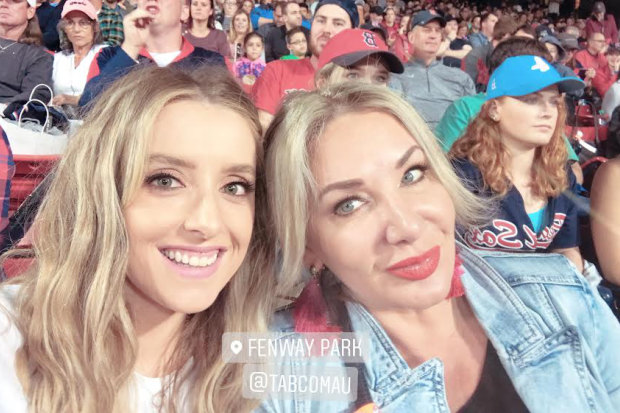
Stephenie Rodriguez with her best friend Liz Beath at the baseball in Boston two days before she collapsed from the infection.Credit: Courtesy of Stephenie Rodriguez
The next day, they went out for lunch. Feeling tired, Rodriguez opted to have a nap afterwards. “Totally out of character for me,” she says. On their last night in Boston, she decided to dine in the hotel lobby bar rather than go out. Also highly unusual.
September 29 was meant to be their final day in Boston, during which they’d go shoe shopping, then head to the airport. Beath, who’d started getting worried about her friend during their Harvard visit, when Rodriguez was “running a high fever and visibly sweaty”, noticed during their shopping expedition that her friend was grumpy and looked unwell. “I suggested she go see a doctor, but she said it wasn’t worth waiting at a hospital when we only had a couple of days.” Resisting another call to see a doctor, Rodriguez
instead agreed that they head to the airport early.
“She was very slow getting through security, fumbling with her bags,” recalls Beath. “People behind us were getting impatient. We eventually got to the lounge and watched our bags go on the plane. I tried to get her to eat and drink something but she wasn’t interested. I went to the bar to get more water. Before I could get back, a man came over and said to me, ‘Something is seriously wrong with your friend.’ ”
Beath rushed back and tried to get Rodriguez to drink. “It dribbled down her front. I still remember her looking up at me with the most terrified look in her eyes. It was like she was trying to say, ‘Help me’, but couldn’t get the words out. She was incoherent.
I screamed, ‘Somebody help me, I need a doctor!’ Luckily, there were three in that lounge.”
They moved Rodriguez onto the carpet. Placing her in the recovery position, they checked her vitals and cleared her airways, initially suspecting she was having a stroke. Within minutes, an ambulance crew and officers from the sheriff’s department arrived. Rodriguez, who was now vomiting, was strapped onto a stretcher and whisked through the crowded terminal.
Petrified, Beath grabbed their passports, backpacks and shopping bags and raced to keep up, her heart thumping as they snaked their way through a labyrinth of passageways and tunnels to a waiting ambulance on the tarmac. Sirens blaring, flashing lights blazing, she was scared witless. “They said we were going to Massachusetts General Hospital. It felt like I was watching a scene I wasn’t actually part of. When we got to the hospital, they asked me a million questions ... if she’d had any drugs. I told them cold and flu tablets. They ruled out an allergic reaction.”
Doctors and nurses descended. Beath recalls counting 16 people; they were drawing blood, checking Rodriguez’s vitals, cutting her clothes off. A trembling mess, Beath called her mother in Canberra, then her fiancé, lawyer Chase Deans. Rodriguez’s ex-husbands Paul Dermatis and Michael Zacharia were soon notified, along with her GP Zac Turner and another of her close girlfriends, Fiona O’Donnell.
Beath still had Rodriguez’s African and Indian itinerary in her phone. Together with the medical team, she scrolled through her Instagram feed searching for clues. Turner was en route to a medical conference in Monte Carlo when he got the news. In his early medical years he’d studied infectious diseases, and, as one of the investors in WanderSafe, he knew Rodriguez had just been to Africa and India. Sending SMS messages from his plane seat, he planted the seed that she could be carrying malaria. He suggested she be treated with the relatively new drug Artesunate. It was not widely known in the US, where malaria is less common, and at that stage, was not yet approved for use there (that would come the following year, in 2020).
Twenty hours later, an infectious diseases specialist confirmed Turner’s suspicions. Rodriguez, by now in a coma, had contracted cerebral malaria.
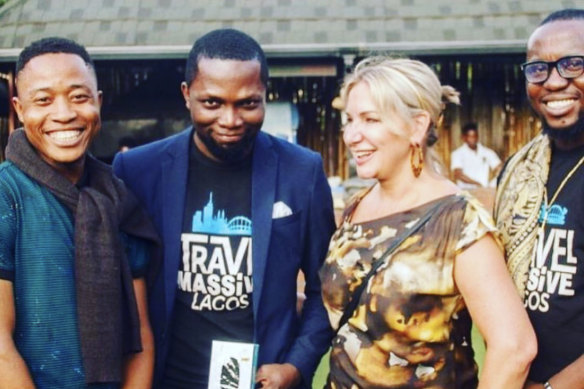
Stephenie Rodriguez in Lagos in 2019, where she believes she was bitten by a mosquito and contracted malaria.Credit: Courtesy of Stephenie Rodriguez
A distraught Beath checked into a hotel next to the hospital, only to return and wait outside Rodriguez’s room. The next day, a counsellor told her that Rodriguez’s condition was deteriorating and asked her to consider if her friend should be cremated, providing pamphlets for local crematoriums. Alternatively, perhaps she’d want to make arrangements to transport her body back to Australia? “I was thinking, ‘What the hell?’ I didn’t want to even contemplate that,” says Beath, her voice breaking as she relives the horror.
Friends and family started to fly in, including Deans, O’Donnell and Dermatis, the latter bringing Rodriguez’s then 13-year-old son. “Constantine is the most important thing in the world to Stephenie,” says O’Donnell, a Canberra childcare entrepreneur. “The doctors thought having him there might trigger something, a response. But it was a big risk, we were looking for a miracle.
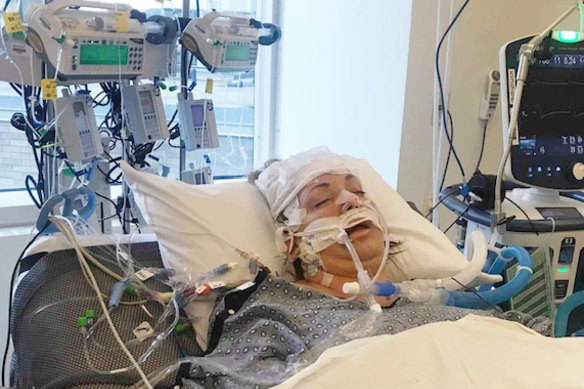
Rodriguez intubated in Boston. When they took the tube out, her first words were: “Who the f... gets malaria?”Credit: Courtesy of Stephenie Rodriguez
She was hooked up to so many machines, monitors, tubes and cables everywhere. She was unresponsive and unrecognisable. I just couldn’t believe our beautiful, vibrant Stephenie was the same person lying on that bed.“
The Boston doctors received approval from US authorities to try Artesunate, and a batch was flown to her from the US Centres for Disease Control and Prevention in Atlanta. Cerebral malaria victims rarely get too far away from where they were bitten since the parasite kills fast, but it was now more than two weeks since Rodriguez had been bitten, and she’d since travelled about 40,000 kilometres across four continents. As the Artesunate attacked the parasite, she went into severe septic shock and organ failure.
At the critical moment of life or death, the doctors said there was one more thing they could do: up the vasopressors, drugs that cause the blood vessels to contract in people with severely low blood pressure. In Rodriguez’s case, the lift was extreme, increasing blood flow to her vital organs – and away from her extremities. “It was the last trick in the bag, and they cautioned my family that if I survived, there would be collateral damage. The vasopressors robbed my feet and hands, the things furthest from my heart, of blood and like frostbite, the areas without blood and oxygen began to die,” Rodriguez says with clinical detachment. “My family pleaded for them to do everything they could to save my life. The damage I sustained to my feet and hands didn’t come from cerebral malaria: it came from the treatment of severe septic shock.”
Against all odds, it worked. Rodriguez came out of her coma on October 9, 2019. Still intubated, she recalls being unable to move anything other than her face and mouth. Two days later, when they took the tube out, her first words were: “Who the f... gets malaria?”
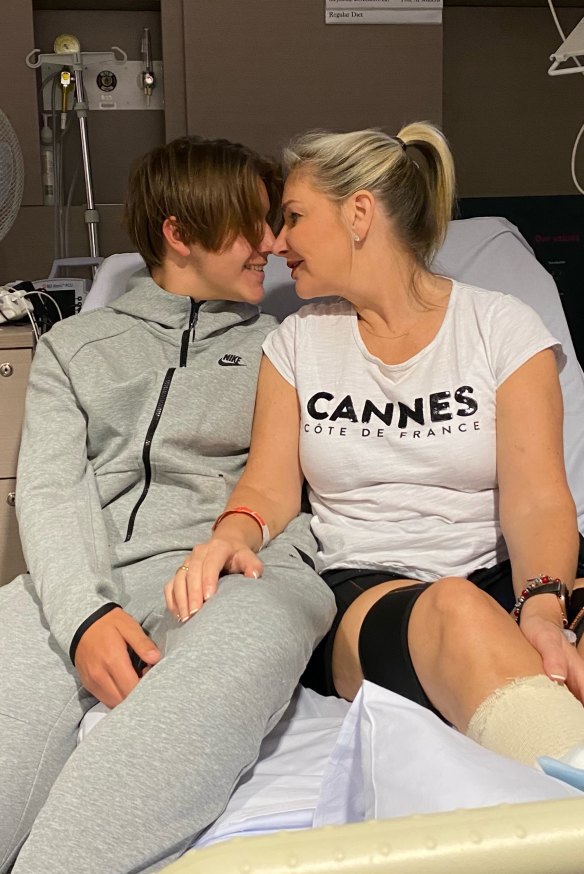
Rodriguez back in Australia with her son Constantine, 15. When the malaria infection took hold in Boston, Constantine was flown to the US to be by her bedside.Credit: Courtesy of Stephenie Rodriguez
On October 14, Rodriguez was moved out of intensive care, at which point her Australian travel insurer insisted she be airlifted back to an Australian hospital. “So they could stop the meter running,” she says drily. A few weeks later, she flew back to Sydney, then was transferred on to Canberra Hospital via ambulance. Here, she was told she would need to have both her legs amputated above the knee, along with several fingers. “But I could still feel my arches and tops of my feet, even though my toes were turning from purple to black and I could not feel them,” she says.“I resisted. I said, ‘We don’t know what won’t heal, and I prefer to wait.’ ”
The next day, Fiona O’Donnell visited and listened to the medical advice. When the doctors left, she told Rodriguez: “Self-discharge, baby! I am taking you to Sydney for a second opinion.” That afternoon O’Donnell pulled up in her Porsche Macan, loaded into it her friend and a wheelchair, and hit the Federal Highway, “Thelma and Louise-style”.
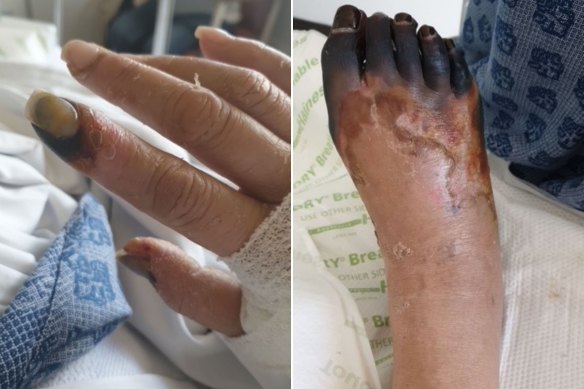
Life-saving drugs caused necrosis of her hands and feet.Credit: Courtesy of Stephenie Rodriguez
Rodriguez would spend most of 2020 in four different Sydney hospitals, being treated by a variety of doctors and specialists in a battle to save her dying feet and hands. That included multiple skin grafts, “flap surgeries” on her heels and having her remaining toes amputated. She underwent a total of 28 operations to her feet, including stem cell treatments and peptide injections to “regrow” her flesh, along with endless bouts in hyperbaric chambers.
Meanwhile, she had surgery on her right hand to remove dead bone in the index finger and dead muscle from the web between the thumb and index finger, and to fuse her thumb into place. Her hand has since regained almost all its function, though it bears the indelible scars of her ordeal. While her index finger is now slightly shorter, it’s intact.
By February this year, however, her feet were still a problem. Wheelchair-bound, she was unable to stand because of the unbearable pain, and the skin had still not closed up around her weeping heels. A new set of MRI scans revealed bad news: her heel bones were dying. “The body dislikes dead things and tries to get rid of them naturally, like a splinter,” she says. “I had these open wounds for a year because my body was rejecting my bones.”
Rodriguez had by now been accepted into the National Disability Insurance Scheme. The application had asked her to express her goals. “That was easy: to walk again unaided,” she says. The second question had asked who would help her achieve that.
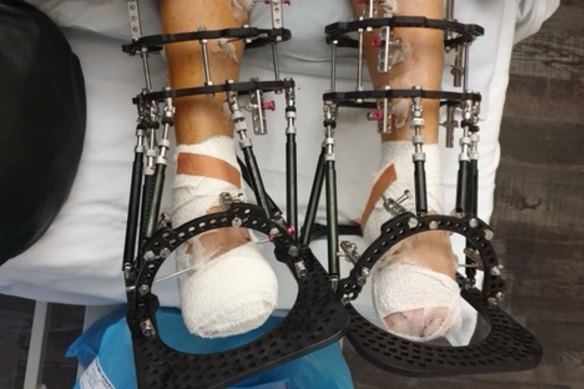
Rodriguez after her toes were amputated in Sydney.Credit: Courtesy of Stephenie Rodriguez
It was a long shot, but Rodriguez wrote down Professor Munjed Al Muderis, the 2020 Australian Of The Year and a Sydney-based world leader in transcutaneous osseointegration technology, developing robotic artificial limbs for amputees designed to be as close to the human anatomy as possible. Coincidentally, Rodriguez had heard the professor speak at a TEDx Sydney talk in 2015, when he’d shared his story of fleeing Saddam Hussein’s Iraq after refusing to cut off the ears of army deserters. Feeling inspired, Rodriguez had already connected with him on social media.
“I came home from that appointment crying. That wasn’t what I wanted to hear.”
“Perhaps he could give me bionic toes?” Rodriguez recalls thinking before her first consultation. Al Muderis told her there was no sense worrying about the toes, her feet were the real problem. “If I wanted to get out of the wheelchair and walk again, I would have to trade my dead, sore feet in for some bionic ones,” she recalls. “I came home from that appointment crying. That wasn’t what I wanted to hear.”
Al Muderis says it didn’t take long to convince his patient. “Stephenie is a reasonable person. While her limbs were not entirely dead, she already had a partial amputation,” he tells me. “Her feet had become a nuisance, painful and no longer functioning. There was the potential of further infection spreading,” he says. “We had a very open and frank discussion about the reality of her condition and what her options for management were, and what sort of life she wanted.”
Finally accepting the inevitable, on March 31 this year Rodriguez underwent bilateral feet amputations. New titanium rods were inserted into her shinbones. She spent three weeks in hospital, then another eight weeks working with physios to learn how to walk again. In the process she discovered her new centre of gravity: “In my hips.”
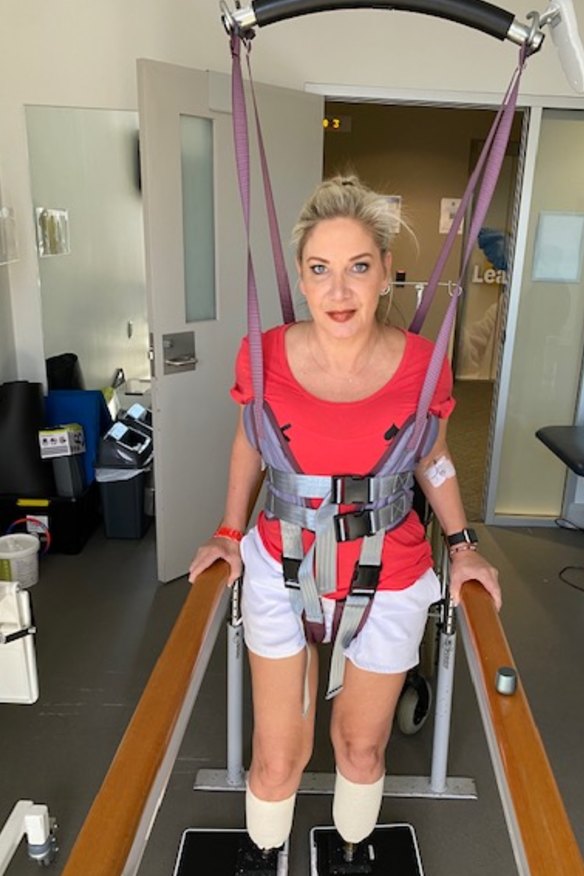
Rodriguez learning to bear weight, two weeks after losing her feet.Credit: Courtesy of Stephenie Rodriguez
Since then, Rodriguez has spent a minimum of three days a week with physiotherapists, slowly but surely rebuilding her body. She shows me how her articulated ankle and foot mechanisms can pivot depending on what sort of shoes she wants to wear, a huge leap forward from her less agile “starter” feet, essentially rigid L-shaped appendages that forced her to walk “like a tin soldier”. She gets up to demonstrate her ability to rock back and forth on her feet, bending her knees and activating her new ankles. I momentarily hold my breath.
“Stephenie doesn’t want to run a marathon, she just wants to get back to where she was before, to get on a plane, to walk and dance.”
Her blonde hair coiffured around her face like Marilyn Monroe, her make-up expertly applied, her black dress hugging her fit-looking figure, she’s just as immaculate as when I first met her. “I owe it to Pilates and my physiotherapists,” she says. “After 18 months in a wheelchair, I had to rebuild my body and regain my strength.”
One of those physiotherapists, Zac Moukaddem, has been impressed by her work ethic. “Her determination is next-level,” he tells me. “Everyone has a different goal. Some people just want to get to a certain point and that’s it. Stephenie doesn’t want to run a marathon, she just wants to get back to where she was before, to get on a plane, to walk and dance ... but she’s applying the same determination as a Paralympian to get there.”
Watching her, contemplating how vastly and irrevocably her life has changed, I can’t help but wonder whether she regrets not taking anti-malarial drugs before her fateful trip to Nigeria. It likely wouldn’t have made any difference, she insists; in Boston she was told that in her case, malaria medication may not have been enough. “I’d been to Africa before and knew malaria was there, but I calculated my risk was low and took precautions by limiting my exposure outdoors.”
She doesn’t remember seeing stark warnings about malaria in the region in her online research before she left, “just warnings about being kidnapped or raped”. Nor does she wish she’d never gone to Africa, although she does advise “knowing absolutely everything” before you visit another country, which she did not.
“I take a deeper, more philosophical view of what happened to me,” she says in summary. “I believe this was meant to be my lesson in life. I don’t use the word ‘accident’, this ordeal got me to where I needed to be emotionally and spiritually ... I have a much deeper sense of purpose and gratitude than I ever did before. Gratitude for life, for human kindness, for the medical fraternity, for advances in science.”
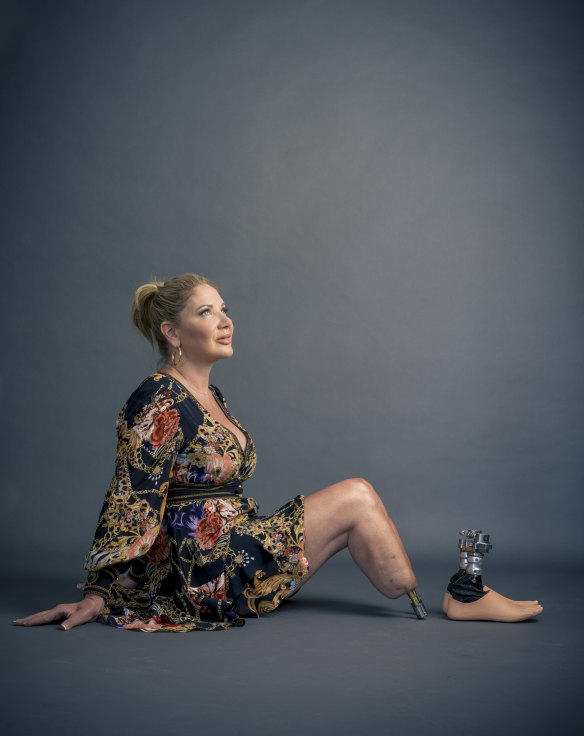
“It was very hard for me to get to a point of self-acceptance of my new feet, but I now look at them as things of beauty.”Credit: Tim Bauer. Hair & make-up by Michelle Dubé
Does she wish she’d amputated her feet sooner? “No,” she says again. “Even though it was incredibly painful and frustrating, I had to go through that process first. Cutting off a part of your body is an unimaginable thing for anyone to face. I had to give myself every chance I could ... I would have lost a lot more of my legs and my fingers if I’d said yes at the start. It was very hard for me to get to a point of self-acceptance of my new feet, but I now look at them as things of beauty, and I try to stay focused on the bright side. But of course, I have my off days too.”
The off days include phantom pains, excruciating sensations of her heels burning, or toes being stepped on, for which she has pulsed radiofrequency stimulation to readjust the disordered function. On the upside, she jokes, “I’ll never have fat ankles”. She tells me her allen key has become her most important accessory. She’s currently searching for a jeweller to fashion one she can wear.
I bring up those Chanel heels again. For the past two years, they’ve remained in her wardrobe, wrapped in their original tissue paper and sitting in their original boxes. Could she ever wear them again?
“Abso-bloody-lutely! Just you wait.”
To read more from Good Weekend magazine, visit our page at The Sydney Morning Herald, The Age and Brisbane Times.
The best of Good Weekend delivered to your inbox every Saturday morning. Sign up here.